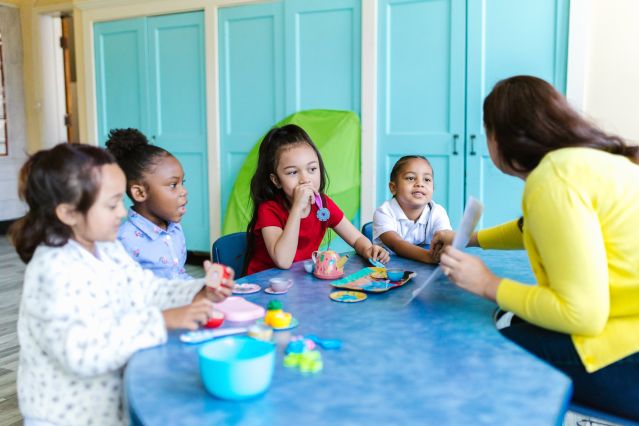Race and Ethnicity
Racial Colorblindness Is Multifaceted
Psychology provides clues on how to promote a healthy colorblind mindset.
Posted December 22, 2023 Reviewed by Hara Estroff Marano
Key points
- Racial colorblindness is actually several different things, and not all of them are negative.
- Equality orientation is linked with positive outcomes, whereas color evasion is not.
- Social environments like schools can normalize equality and egalitarianism.

In a previous article, I argued that some psychological research has mismeasured racial colorblindness, characterizing it as defensive posturing, rather than a nuanced and thoughtful approach to improving society. Because of this, we can’t really draw clear conclusions about whether a colorblind approach, as advocated by thinkers like Coleman Hughes, would be effective at reducing racial prejudice. I also noted points for which I both agree and disagree with Hughes and psychologist Adam Grant, who spoke up against racial colorblindness. Grant cited a meta-analysis showing that a race-conscious mindset is superior to a colorblind mindset in predicting positive social outcomes (i.e., less bias and discrimination).
But as other scholars have noted, there are limitations with how racial colorblindness has been studied. In a recent paper, a group of scientists noted how colorblindness may have negative and positive aspects. On one hand, majority group members with a colorblind mindset may overlook instances of discrimination in society (negative). On the other hand, those with a colorblind mindset may use efforts to prevent their own biases from influencing their behaviors (positive).
Three Facets of Racial Colorblindness
With this in mind, the researchers created a new questionnaire measure of colorblindness and showed how colorblind mindset is actually comprised of three separate viewpoints about race. The first view is called equality orientation. This is measured using items such as, “Everyone should be treated the same regardless of their race or ethnicity,” and “Learning about the similarities between racial and ethnic groups will help us develop a more harmonious society.” This variable seems to capture the idea that we should strive for equality and to focus on similarities rather than differences.
The second view is called color evasion, which is measured with items such as “Talking about racial issues causes unnecessary tension,” and “The topic of race is something that should generally be avoided.” This seems to reflect a defensiveness about race and racism, and a desire to avoid difficult social problems.
The third view is called rejection of racial categorization, which is measured with items such as “Seeing people in terms of race or ethnicity leads to prejudice” and “Categorizing people by race is in and of itself racist.” This seems to reflect an avoidance or denial of racial and ethnic groups and a desire to not have such social groups exist at all.
The researchers found that the three aspects of racial colorblindness are quite different from each other. The first variable, equality orientation, was correlated with a variety of positive social variables, while rejection of racial categorization showed less clear patterns, whereas color evasion was linked with more negative tendencies.
For example, those who scored higher on equality orientation also tended to score lower on measures of racism, whereas the opposite was true for color evasion, which was associated with higher racism scores. Equality orientation was also highly correlated with a preference for diversity and warmth towards minority groups. Color evasion, by contrast, was linked with colder attitudes toward minorities, including ethnic groups and also non-racial groups like lesbians and gay men.
Basically, the authors found evidence that at least one aspect of a colorblind mindset is linked with positive tendencies. Having an egalitarian approach that emphasizes similarities across ethnic groups and treating people equally seems to bode well. At the same time, other aspects of colorblindness seem to be linked with negative variables, including tendencies toward racial prejudice and bias.
The implication from this paper directly challenges many of the assumptions long held by researchers in this area, including advocates for race consciousness like Adam Grant. The authors said as much in their article [my emphasis added]: “The multifaceted nature of colorblindness suggests that it might be useful to revisit the conclusions drawn from previous research on prejudice that treated colorblindness as a unitary construct to explore the extent to which the specific facets of colorblindness assessed by those measures may have influenced the results of the research.”
I would go a bit further than that. We shouldn’t assume, based on prior studies, that a colorblind mindset is always bad, because those studies suffer from a methodological limitation as researchers lumped disparate aspects of colorblindness together. A colorblind mindset could be really good for society, and we would know this if we studied it carefully.
How Do Egalitarian Norms Develop?
But all of this research on adult participants doesn’t answer the question of how people develop a colorblind or race conscious mindset to begin with. How do these ideas get formed? Are kids taught one way or the other? This is a question for which developmental scientists can offer some clues.
A body of evidence now shows that while school-age kids do show racial biases, toddlers and infants do not. In addition, humans of all ages (including babies) do show the capacity to have biased preferences based on cues of group membership, such as spoken language and accent, and even food choice. This shows that humans are coalitional. We look to form social tribes based on similar features, but those specific features do not come pre-programmed in our brains and therefore must be learned.
In modern society, people might use race, as well as nationality, religion, age, and sex as coalitional cues, or other less intuitive features like body shape. It is not inevitable that children or adults will develop racial biases. Instead, children can be taught to focus on other variables that promote group kinship. This is especially likely to happen when kids of different racial/ethnic backgrounds are integrated together into schools and extracurricular programs.
In diverse social environments like these, colorblind norms develop. Kids learn that it’s wrong to treat people differently based on race, though they may develop favoritism based on other variables, such as which sports team they support. In this sense, children’s attitudes are formed based on norms and social cues for how they should identify themselves culturally. If kids are taught that it's okay to tease someone who supports a different baseball team, then they are more likely to behave this way. And, if kids are raised to believe that skin color is an important identity marker because they observe adults making each other's race very salient in their social interactions, then kids will pick up on this and emphasize race more strongly in their own social lives. But if kids are raised in multicultural environments where adults are not calling attention to race, and instead focusing on other social cues, then kids will show less racial bias.
As developmental psychologist Paul Bloom noted, “race matters only insofar as it piggybacks on coalition…. Race becomes important because in some societies people learn that skin color and certain body features indicate which of many conflicting groups an individual belongs to. This is in much the same way that we might learn that different sports teams have different-colored uniforms; there is nothing inherently interesting about the color of the uniforms—they matter because of what they signal. Racial bigotry develops, then, in much the same way as a child growing up in Boston will come to associate a Red Sox uniform with Us and a Yankees uniform with Them.”
Conclusion: Equality Orientation Is Good
Based on this line of evidence and reasoning, a colorblind mindset starts to make more sense, especially if kids are raised in diverse environments that also promote egalitarianism and equality. If our goal is to reduce racial prejudice, it is within our power to bring kids from different ethnic backgrounds together and teach them to focus on their similarities. Looking at some of the items measuring equality orientation (a facet of colorblind mindset), some stand out that seem to be consistent with developmental science: “Children should learn that people of different cultural origins often have a lot in common,” and “Schools should aim to foster and support the similarities between students from different cultural backgrounds.” I could be wrong here, but these seem like pretty good ideas that will likely lead to positive social outcomes, and they seem to stem from a genuinely colorblind worldview.
References
Leslie, L. M., Bono, J. E., Kim, Y. S., & Beaver, G. R. (2020). On melting pots and salad bowls: A meta-analysis of the effects of identity-blind and identity-conscious diversity ideologies. Journal of Applied Psychology, 105(5), 453.
Whitley Jr, B. E., Luttrell, A., & Schultz, T. (2023). The measurement of racial colorblindness. Personality and Social Psychology Bulletin, 49(11), 1531-1551.
Kinzler, K. D., & Spelke, E. S. (2011). Do infants show social preferences for people differing in race?. Cognition, 119(1), 1-9.
Kinzler, K. D., Shutts, K., DeJesus, J., & Spelke, E. S. (2009). Accent trumps race in guiding children's social preferences. Social Cognition, 27(4), 623-634.
Bloom, P. (2013). Just babies: The origins of good and evil. Crown Publishers/Random House.




